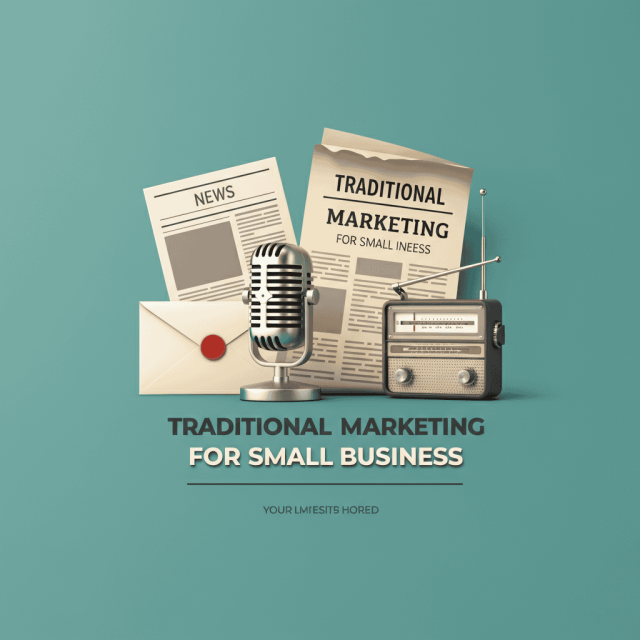Digital marketing dominates conversations about business growth, but traditional marketing strategies remain surprisingly effective for small businesses. While social media and online advertising capture headlines, methods like direct mail, print advertising, and local sponsorships continue to deliver measurable results—especially for businesses targeting local customers.
Small business owners often assume they need to choose between traditional and digital marketing. This creates a false dilemma. The most successful small businesses combine both approaches, using traditional methods to build local brand recognition while leveraging digital tools for broader reach.
Traditional marketing offers unique advantages that digital channels struggle to replicate. Physical touchpoints create lasting impressions, face-to-face interactions build trust faster than online exchanges, and local community connections generate word-of-mouth referrals that money can’t buy. These strengths are rooted in the 7 Ps of traditional marketing, which still shape how small businesses build their brand locally.
This guide explores proven traditional marketing strategies that small businesses can implement immediately, regardless of budget constraints or technical expertise.
Print Advertising That Actually Works
Print advertising might seem outdated, but strategic placement in local publications can generate impressive returns for small businesses. Community newspapers, local magazines, and industry publications maintain dedicated readerships who trust their content.
Successful print campaigns focus on clear value propositions rather than flashy graphics. Include specific offers, contact information, and compelling reasons for customers to act immediately. Track responses using unique phone numbers or promotional codes to measure effectiveness accurately.
Local business directories deserve special attention. Many consumers still consult printed Yellow Pages or community guides when seeking services. A well-crafted directory listing with complete business information often outperforms expensive display advertisements.
Consider seasonal publications like holiday shopping guides or summer activity booklets. These targeted publications reach customers actively seeking specific products or services, increasing conversion rates significantly.
Direct Mail That Gets Results
Direct mail campaigns achieve average response rates between 3-5%, significantly higher than email marketing’s 0.6% average. Physical mail pieces create tangible connections with potential customers that digital messages cannot match.
Effective direct mail campaigns start with precise targeting. Purchase mailing lists based on demographics, income levels, or geographic proximity to your business. Local post offices provide valuable demographic data for specific ZIP codes, helping you identify ideal customer concentrations.
Design matters enormously in direct mail success. Professional-looking pieces with clear calls-to-action outperform amateur designs consistently. Include limited-time offers, discount codes, or free consultations to encourage immediate responses.
Postcards often deliver better results than elaborate brochures while costing significantly less to produce and mail. A compelling headline, brief benefit statement, and clear contact information can fit comfortably on a standard postcard format.
Track direct mail performance by including unique offer codes or dedicated phone numbers. This data helps refine future campaigns and justify marketing investments to stakeholders.
Radio and Local Television Opportunities
Local radio stations offer affordable advertising opportunities that many small businesses overlook. Morning and afternoon drive-time slots reach commuters who live and work in your service area, creating ideal targeting opportunities.
Radio advertising works best for businesses offering services rather than products. Listeners cannot examine physical items through audio advertisements, but they can understand service benefits and remember business names for future reference.
Local television stations often provide cost-effective advertising slots during less popular programming. Late-night, early morning, or local news segments frequently offer reasonable rates with surprisingly good local audience reach.
Consider sponsoring weather segments or local news features rather than purchasing traditional commercial slots. Sponsorship announcements often cost less while associating your business with trusted local programming content.
Many cable providers offer hyper-local advertising zones that target specific neighborhoods or communities. These targeted campaigns can be surprisingly affordable while reaching exactly the right audiences for location-dependent businesses.
Community Involvement and Local Sponsorships

Active community participation builds brand recognition more effectively than paid advertising in many situations. Sponsoring local sports teams, school events, or community festivals creates positive associations while supporting worthy causes.
Event sponsorships provide multiple marketing touchpoints beyond simple name recognition. Sponsor booths allow direct customer interactions, promotional materials distribution, and immediate sales opportunities.
Chamber of Commerce membership offers networking opportunities and credibility boosts that justify annual fees. Regular attendance at chamber events creates personal relationships with other business owners who can provide referrals.
Local charity involvement demonstrates community commitment while generating positive publicity. Choose causes that align with your business values rather than supporting every request that arrives.
School fundraising partnerships work particularly well for family-oriented businesses. Parents notice businesses that support their children’s activities and often become loyal customers as a result.
Networking and Referral Programs
Word-of-mouth referrals remain the most trusted form of advertising across all industries. In fact, Nielsen studies reveal that 84% of consumers trust recommendations from people they know, making referral-based programs incredibly effective for small businesses that rely on community relationships.. Systematic referral programs encourage existing customers to recommend your business to friends and colleagues.
Professional networking groups like BNI (Business Network International) create structured referral opportunities with other business owners. Weekly meetings build relationships that generate consistent referral streams over time.
Industry association memberships provide credibility and networking opportunities with potential partners or customers. Active participation in association events increases visibility within your professional community.
Local business mixers and after-hours events create casual networking opportunities that feel less sales-focused than formal meetings. These relaxed environments often produce the most authentic business relationships.
Customer referral incentives should benefit both parties. Reward existing customers for successful referrals while offering new customers welcome bonuses that encourage them to try your services.
Measuring Traditional Marketing Success
Traditional marketing measurement requires more creativity than digital analytics, but accurate tracking remains possible with proper planning. Establish baseline metrics before launching campaigns to measure improvement accurately.
Use unique phone numbers for different marketing channels to track which advertisements generate calls. Many phone service providers offer call tracking services that integrate with existing business phone systems.
Promotional codes help track print advertisement effectiveness while encouraging customer action. Create memorable codes that relate to your business or the publication where advertisements appear.
Customer surveys reveal how new clients discovered your business. Include discovery questions on intake forms or service agreements to identify successful marketing channels.
Sales cycle analysis helps attribute revenue to specific marketing activities. Track the time between initial contact and final purchase to understand which channels produce the highest-quality leads.
Making Traditional Marketing Work for Your Budget
Traditional marketing doesn’t require massive budgets to produce meaningful results. Start with one or two strategies that match your target audience and expand successful campaigns gradually.
Negotiate with local media outlets for package deals or off-peak rates. Many publications and radio stations offer significant discounts for first-time advertisers or multiple insertion commitments.
Collaborate with complementary businesses on joint marketing efforts. Shared costs make expensive advertising more affordable while expanding your reach to compatible customer bases.
Seasonal timing affects traditional marketing costs significantly. Plan campaigns during slower advertising periods to secure better rates and less cluttered promotional environments.
Building Your Traditional Marketing Foundation
Traditional marketing strategies offer small businesses valuable opportunities to connect with local customers in meaningful ways. These time-tested methods complement digital marketing efforts while providing unique advantages that online channels cannot replicate.
Start by selecting two traditional marketing strategies that align with your target audience and budget constraints. If you’re unsure where to begin, explore what traditional marketing platforms are available and which fit your business goals. Implement them consistently for at least three months before evaluating results or adding new approaches.
Success in traditional marketing requires patience and persistence. Unlike digital campaigns that can show immediate results, traditional methods build momentum over time through repeated exposure and community relationship development.
The businesses that thrive combine traditional and digital marketing strategies strategically, using each channel’s unique strengths to create comprehensive marketing programs that reach customers wherever they are.









